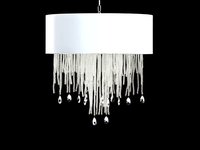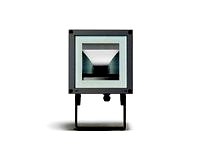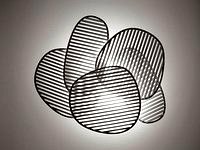Complèments
Ergänzungen
Complements
Complementi
Complèments
Ergänzungen
Complements
Complementi
Vérité
Cassina Dining
428
Complementi
Complements
Ergänzungen
Complèments
D04 Vérité
Nel 1940 Charlotte Perriand intraprese il suo primo viaggio in
Giappone. Qui decise di sviluppare numerosi dei suoi modelli creati
in Francia, adattandoli alla limitata reperibilità dei materiali, dovuta
all’economia di guerra, e integrandoli con le straordinarie abilità
artigianali giapponesi. L’anno successivo debuttò a Tokyo la mostra “A
Contribution to the Interior Furnishings of a House in the Year 2601.
Selection, Tradition, Creation”, trasferita poi a Osaka. Proprio per tale
mostra, Charlotte Perriand commissionò due tappeti di lana, Vérité e
Graffiti, prodotti con tecniche di tessitura locali capaci di intrigare il
gusto occidentale.
Il tappeto Vérité raffigura l’ideogramma giapponese utilizzato
per ‘Verità’, o il carattere mandarino che in cinese significa
‘Libero’, impresso nello spessore rosso brillante del pile: una forte
dichiarazione in un periodo storico che vedeva il Giappone ancora
impegnato nel conflitto con la Cina iniziato nel 1931. Attingendo
all’eredità culturale dell’Estremo Oriente, il simbolo venne tracciato
seguendo l’elegante calligrafia utilizzata dal monaco buddista Kaiso
durante la dinastia Tang.
Ogni fase della produzione del tappeto è eseguita meticolosamente
a mano: 125.000 nodi per metro quadrato annodati singolarmente
per un totale di 12-16 settimane di lavorazione, rigorosamente esente
da materiali sintetici, macchinari industriali, acidi e prodotti chimici.
Tutte le fasi della produzione sono affidate all’atelier di cc-tapis,
nella regione nepalese Boudha alle porte di Kathmandu, utilizzando
materiali naturali pregiati e competenze artigianali tramandate di
generazione in generazione.
Charlotte Perriand made her first trip to Japan in 1940. While there,
she developed many of the furniture models she produced in France,
adapting them to the limited availability of materials (due to the
war economy) and completing them by applying the extraordinary
Japanese artisan skills she had learned. The next year a show entitled
“A Contribution to the Interior Furnishings of a House in the Year
2601. Selection, Tradition, Creation” made its debut in Tokyo and
then moved to Osaka. Specifically for this show, Charlotte Perriand
commissioned two wool rugs, Vérité and Graffiti, produced with local
weaving techniques capable of appealing to Western tastes.
The Vérité rug depicts the Japanese ideogram for ‘Truth’ or, the
Mandarin character that in Chinese means ‘Free’ impressed into the
brilliant red thickness of the pile: a bold declaration in a historic period
when Japan was still engaged in the conflict with China that began in
1931. Drawing upon the cultural heritage of the Far East, the symbol
is traced using the elegant calligraphy employed by Buddhist monk
Kaiso during the Tang dynasty.
Each phase of production is meticulously carried out by hand: 125,000
knots per square meter, individually knotted and requiring a total of
12-16 weeks of labour. The rugs are strictly free of synthetic materials,
industrial workmanship, acids and chemical products. All production
phases are entrusted to the cc-tapis atelier, in the Nepalese Boudha
region just outside Kathmandu, which uses premium natural materials
and artisan skills handed down from one generation to the next.
1940 unternahm Charlotte Perriand ihre erste Reise nach Japan.
Hier beschloss sie, viele der Modelle, die sie in Frankreich entworfen
hatte, weiterzuentwickeln, sie an die aufgrund der Kriegswirtschaft
begrenzte Verfügbarkeit von Materialien anzupassen und sie mit
außergewöhnlicher japanischer Handwerkskunst zu verbinden. Im
folgenden Jahr begann in Tokyo erstmalig die Ausstellung „Ein Beitrag
zur Inneneinrichtung eines Hauses im Jahr 2601. Auswahl, Tradition,
Schöpfung“, die anschließend nach Osaka verlegt wurde. Für diese
Ausstellung gab Charlotte Perriand zwei Wollteppiche in Auftrag, Vérité
und Graffiti, die mit lokalen Webtechniken hergestellt wurden, die den
westlichen Geschmack ansprachen.
Auf dem Vérité-Teppich ist das japanische Ideogramm für „Wahrheit“
oder das chinesische Mandarin-Zeichen für „Freiheit“ in den leuchtend
roten Flor eingeprägt: ein starkes Statement zu einer Zeit, als Japan
noch in den 1931 begonnenen Konflikt mit China verwickelt war. In
Anlehnung an das kulturelle Erbe des Fernen Ostens wurde das Symbol
in Anlehnung an die elegante Kalligrafie des buddhistischen Mönchs
Kaiso während der Tang-Dynastie gezeichnet.
Jede Phase der Teppichherstellung wird in sorgfältiger Handarbeit
durchgeführt: 125.000 Knoten pro Quadratmeter, einzeln geknüpft,
insgesamt 12 bis 16 Wochen lang verarbeitet, streng frei von Synthetik,
Industriemaschinen, Säuren und Chemikalien. Alle Produktionsschritte
werden dem cc-tapis-Atelier in der nepalesischen Region Boudha am
Rande von Kathmandu anvertraut. Dabei werden edle Naturmaterialien
verwendet und die handwerklichen Fähigkeiten von Generation zu
Generation weitergegeben.
En 1940, Charlotte Perriand entreprend son premier voyage au
Japon. Elle décide d'y développer plusieurs modèles qu'elle a créés
en France, en les adaptant à la disponibilité limitée des matériaux,
due à l'économie de guerre, et en y intégrant les extraordinaires
compétences artisanales japonaises. L'année suivante, l'exposition
« Contribution à l'équipement intérieur de l'habitation, Japon 2601.
Sélection, tradition, création. » s'ouvre à Tokyo puis à Osaka. C'est
précisément pour cette exposition que Charlotte Perriand commande
deux tapis en laine, Vérité et Graffiti, fabriqués selon des techniques
de tissage locales et en mesure de répondre au gout occidental.
Le tapis Vérité représente l’idéogramme japonais utilisé pour « Vérité
», ou le caractère mandarin qui en chinois signifie « Libre », ciselé
dans l'épaisseur rouge vif du velours : une déclaration audacieuse
à une époque où le Japon est encore impliqué dans la guerre qu'il
a commencée en Chine en 1931. Puisant dans l'héritage culturel
d'Extrême-Orient, le symbole recourt à la belle calligraphie utilisée par
le moine bouddhiste Kaiso pendant la dynastie Tang.
Chaque étape de la fabrication du tapis est exécutée
méticuleusement à la main : 125 000 nœuds par mètre carré
noués individuellement pour un total de 12 à 16 semaines de travail,
sans aucunement utiliser de matériaux synthétiques, d'acides, de
produits chimiques ni de machines industrielles. Toutes les étapes
de la fabrication sont confiées à l'atelier de cc-tapis, dans la région
népalaise de Boudha aux portes de Katmandou, et fait appel aux
meilleurs matériaux naturels et à un savoir-faire artisanal transmis de
génération en génération.
ITA
ENG
DEU
FRA
230
90.5”
300
118.1”
300
118.1”
D04 V1
D04 V2
400
157.5”
Materiali
· Lana himalayana.
Material
· Himalayawolle.
Materials
· Himalayan wool.
Matériaux
· Laine de l'Himalaya.
Designed by
Charlotte Perriand, 1941
Produced
Cassina with cc-tapis, 2022
Cassina iMaestri Collection







